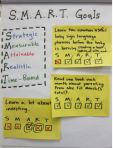I’m doing a big of catch-up. I signed up for a Virtual Admin Mentor Program (#SAVMP) – one challenge per week that began in August.
The Week 3 challenge asks me to address important thoughts I had starting at a new school in my new role. Seems like a good end-of-year-reflection – especially since the end of each school year is also the end of the calendar year.
What has been successful?
Documentation. I was better at keeping student behavioural notes as an administrator than I was as a classroom teacher.
One of my first welcome gifts was a small prayer diary. I used the diary to note down every important outgoing and incoming phone call, especially those from parents. I made notes about significant conversations I had with teachers. The notes were brief and messy – I’m pretty sure no one else would be able to make sense of them. But I remembered the instances. And I prayed about many of the instances.
When I started having multiple entries on the same student, I would start a Word document. The document included only facts – who said what, places where incidents happened, interventions and results.
The diary notes and documents helped me better identify patterns, frequencies, and levels of success with interventions. What have we tried? What have we not tried? What has worked? What are possible next steps?
I also have data that I will use as a baseline for 2014 and beyond. This next year, the school is focusing on creating a culture based on the philosophies of Positive Education and Restorative Justice. As I continue to document in 2014, I can see whether or not the cultural shift is affecting the frequency and intensity of particular student behaviours.
What didn’t work?
I know some teachers at my school read this blog. It would probably be best to ask them (feel free to leave a comment – I can take it).
In Term 2, I introduced professional readings into the Junior School meetings. Teachers could choose to read from a selection of professional articles or books. Some were related to teaching students with autism. Others focused on reading books on second language acquisition. Still others read the Daily 5, The (Second Edition): Fostering Literacy in the Elementary Grades
or Launch an Intermediate Writing Workshop: Getting Started with Units of Study for Teaching Writing, Grades 3-5.
.
The first week, teachers had 30 minutes to do the reading and 30 minutes to discuss. Discussions were focused around the following protocols:
- What did the article/chapter say?
- What were you thinking as you read?
- What questions did it raise?
- What does this mean for your classroom?
Two other weeks, teachers were expected to do the readings in advance of the meetings. I noticed the discussions weren’t as rich those weeks. On the one hand, I was disappointed. On the other hand, I remembered that we communicate the importance of things by the time we set aside for them. If I believed the reading was truly important, I had a responsibility to set time aside for the reading as much as the discussion.
Both reading and discussion time got lost in Term 3 due to the implementation of a school-wide assessment goal. I planned to resurrect the readings in Term 4. Then I broke my leg. Best laid plans…
The professional readings-as-part-of-meetings fizzled. But it wasn’t a total loss. Teachers began sharing other books that they were reading. One teacher became hugely passionate about Writing Workshop and gathered a host of new resources to share with me. Another teacher started asking for links to tech blogs. Still another team implemented the Daily 5, adapting it to fit the needs and constraints of their open classroom.
In 2014, I’ll get feedback from teachers on how the process worked and ask for suggestions on ways we can continue to grow a culture that regularly reads professional literature.











